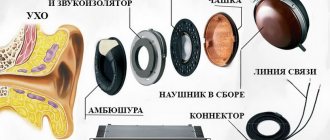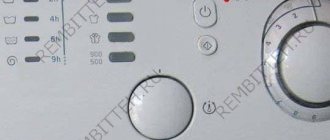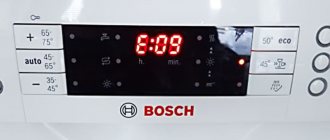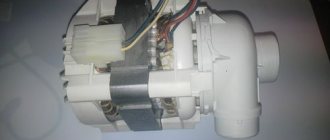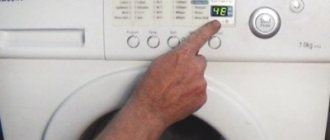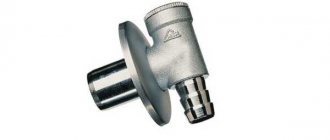Why is the salt light on in my dishwasher? How does it work and what does it say? In this article we will look at all the reasons, possible breakdowns and tell you what to do.
The manufacturer installed indicators on the control panel to make using the dishwasher easy. With their help, you can monitor at what stage of the wash, whether there is enough detergent and rinse aid in the car. All symbols are collected in the instructions; we will only focus on the salt symbol.
What is a salt indicator for?
Since water in Russian regions is hard and contains heavy impurities of calcium and magnesium, manufacturers have installed ion exchangers with resin in dishwashers. Resin particles attract heavy impurities, saturating the water with sodium. What does it give:
- Prevents the settling of limescale on PMM parts.
- Improves washing quality. Softened water dissolves detergent better.
- Saves dishes from white deposits and stains.
The most important thing is that the ion exchanger extends the life of the dishwasher. When the resin in the tank runs out, a special salt comes to the rescue. How does she look?
Special salt is similar to regular salt, but its crystals are much larger. It is purified, so it contains only sodium chloride. How to choose dishwasher salt, read in a separate article.
This is what the ion exchanger looks like:
A special sensor detects the remaining salt in the machine. If the product runs out, the icon flashes; if it has already run out, it lights up. If the light in your Bosch or Siemens dishwasher is constantly on and does not go out, it’s time to replenish the ion exchanger.
The first Hansa and Bosch models do not have such an indicator. Therefore, users have to periodically open and check the presence or absence of salt in the compartment.
The harder the tap water, the more salt is consumed. Often, when purchasing equipment, a test strip is included to determine the amount of impurities. To find out the result, you can do this:
- Call the water utility.
- Use litmus paper (test strip).
Users offer their own methods, however, they do not give an exact result. If soap or shampoo does not foam well, and a white coating quickly builds up on taps and mixers, the level of hardness is high.
Other icons on dishwashers
Having become the owner of a new dishwasher, any housewife begins to carefully study its functions and modes. Some identification marks are easy to understand, while others raise a lot of questions. Let's deal with possible difficulties using the example of Bosch dishwasher icons.
- An icon in the form of a saucepan on an open fire. This mode is also called intensive and is intended for washing serious stains from cooking utensils - frying pans, pots, cauldrons and baking sheets. Temperature about 70 degrees, duration almost 2 hours, water consumption 21 liters.
- Button labeled auto. This is the default mode suitable for most devices, except those made of capricious materials. Water temperature 45-65 degrees, consumption 19 liters, program duration 2 hours and 20 minutes.
Note! Sometimes the standard mode is indicated by the image of a tea pair.
- Mode with the inscription eco or, in other words, a glass and a cup on a saucer. This is a pre-rinse mode. Then the dishes are washed at 50 degrees with a water consumption of only 14 liters. Lasts 2 hours and 20 minutes.
- A sign similar to the previous one with the addition of two arrows to the right. Indicates the speed limit. In 30 minutes, using 10 liters of water, the dishes are washed without pre-rinsing at 45 degrees.
- Outdoor shower. Separate pre-rinse mode. It uses 4 liters of water and lasts only 19 minutes. The program cleans the dishes from food residues and prepares them for the main wash cycle.
- Wine glass. A program designed for washing delicate dishes. Lasts 1 hour 15 minutes. Water consumption is 15 liters, water temperature is 40 degrees. Suitable for any fragile products.
- The signs + and -, united by the letter h, indicate the ability to regulate the washing duration yourself.
- Dial with two arrows pointing to the right. Reduces cycle duration by half.
- Fraction 1/2. Useful if you have only half loaded your PMM. The selected mode will consume resources not for a full cycle, but with a savings of 30%.
- A saucepan with arcs on the right and top. This is a designation for intensive zone washing. Water hits the lower part of the PMM with stronger pressure than the upper part. Allows you to distribute dishes inside the chamber according to the degree of contamination.
- Baby bottle with a + sign. A mode designed to disinfect dishes using high temperatures. It is especially often needed for processing children's dishes, but can be used by the housewife at her discretion.
The button labeled Start starts the washing program, and Reset restarts the dishwasher. In addition to keys with symbols, the PMM panel has several indicator lights that help monitor the operation of the dishwasher. Using the same Bosch as an example, let’s look at what they show.
- The brush indicates that washing is currently in progress.
- The word End means the completion of the cycle.
- The faucet symbolizes the process of drawing water.
- Arrows pointing in different directions indicate the presence or absence of salt.
- Snowflake. The rinse aid compartment is full.
If the PMM has a display, then various programs are also equipped with individual indicators.
If they are lit, the program is running. For example, + means washing at high temperatures (from 65 to 75), - means washing in cooler water (from 35 to 45). The words Auto and Eco indicate the corresponding modes. A wine glass and a cup on a tray - high-speed mode. Shower - pre-rinse.
There is also an indicator of the time remaining until the end of the program, and its completion is accompanied by a sound signal. With the most modern PMMs, the end of the wash is announced by a beam appearing on the floor.
Interesting:
- Designations on the Indesit washing machine
- Symbols on the dishwasher
- Marking of Electrolux washing machines
- Where to pour powder in a Gorenje washing machine
- Which dishwasher is better?
- What is the third compartment in the washing machine tray for?
Reader comments
- Share your opinion - leave a comment
Possible problems
It happens that you have just filled the ion exchanger, but the indicator on the panel is still on. What to do?
- Try rebooting the machine. To do this, unplug it, then turn it back on.
- After a reboot, the operation of the equipment should be restored.
If this does not happen, mechanical cleaning will help:
- Disconnect the PMM from the network.
- Using a construction vacuum cleaner, pump out the contents of the tank (salt and water).
- You can use a rubber bulb. Pre-mix the contents and pump out.
- Pour in a full section of water.
- Fill the crystals to the top.
- Remove excess moisture from the pan.
- Turn on the dishwasher.
This is usually enough for the light to stop glowing. But if nothing has changed, you need to check the salt sensor.
- Remove the side panel of the machine by unscrewing the mounting screws.
- Remove the heat exchanger (if equipped). Behind it is a sensor.
- The sensor can be easily removed by unscrewing the fasteners and unfastening the wiring.
- Disassemble it and clean it from plaque and dirt.
- Start the equipment again.
- Is the indicator on? Then you will have to install a new sensor.
Electrolux dishwasher error codes
Depending on the age of your Electrolux dishwasher, it will indicate operational problems either by flashing indicators or by codes on the display starting with i, for example i10 .
If you need spare parts for an Electrolux dishwasher, contact Samodelkin - we have the widest selection of new and used spare parts with a quality guarantee and fast delivery throughout Russia.
| Code | Description of the problem | Possible faults | Possible solution methods |
| i10 (AL5, C1, F1, i11) For machines without a display, the END indicator flashes once every 5 seconds | The dishwasher does not fill the reservoir with water | For a period of time not exceeding 1 minute, the pressure switch relay does not operate. |
|
| i20 (C2, F2, AL6) The indicator flashes twice every 5 seconds on machines without a display, for example Electrolux ESL 94200 LO | Dishwasher does not drain water | The water level relay (pressostat) did not operate within the specified time. |
|
| i30 The indicator flashes three times | The machine stops the operating program (can occur at any stage of washing or rinsing dishes). | The AquaStop system has triggered (more often occurs on machines with full protection against leaks, for example, Electrolux ESL 94655 RO). |
|
| i50 LED flashes 5 times every 5 seconds | The dishwasher operates at maximum speed of the circulation pump (may be accompanied by unusual sounds), and then refuses to carry out the set program. | Circulation pump triac short circuit |
|
| i60 END indicator blinks six times every 5 seconds | The machine does not heat the water or, on the contrary, heats it too much. |
|
|
| i70 LED on the panel blinks seven times | The machine does not heat water when executing the work program. | The problem is the wiring (due to a short or break) in the thermistor. |
|
| i80 A battery of eight rapid flashes with a five-second break | The dishwasher won't turn on. | Problem with external memory unit. |
|
| i90 The indicator flashes 9 times every 5 seconds | The machine can be turned on and off, but the equipment does not respond to an attempt to start the program. When turned on, it produces the specified error. | The control unit is faulty. |
|
| iA0 The END indicator blinks ten times | The machine does not wash dishes. |
|
|
| ib0 11 flashes every 5 seconds | The machine does not execute the work program and displays the specified error. | Triggering of the water turbidity sensor. |
|
| iС0 Flashing from the battery 12 times with five second breaks | The machine stops the workflow and “wait”, giving this error | There is no connection between the electronic board and the control unit. | Carry out diagnostics and, if necessary, replace the electronic board. |
| id0 13 flashes of the END indicator | The machine does not heat the water, the circulation pump does not rotate. The error appears again and again every time you run the working program. | Failure of the tachometer. |
|
| iF0 For cars without a display, there are 14 flashes with a 5 second interval. | The machine stops working mid-cycle. | Problems with filling water, which is not enough to complete the next phase of the program. | Drain the water and restart the program. |
What is a salt indicator for?
Since water in Russian regions is hard and contains heavy impurities of calcium and magnesium, manufacturers have installed ion exchangers with resin in dishwashers. Resin particles attract heavy impurities, saturating the water with sodium. What does it give:
- Prevents the settling of limescale on PMM parts.
- Improves washing quality. Softened water dissolves detergent better.
- Saves dishes from white deposits and stains.
The most important thing is that the ion exchanger extends the life of the dishwasher. When the resin in the tank runs out, a special salt comes to the rescue. How does she look?
Special salt is similar to regular salt, but its crystals are much larger. It is purified, so it contains only sodium chloride. How to choose dishwasher salt, read in a separate article.
This is what the ion exchanger looks like:
A special sensor detects the remaining salt in the machine. If the product runs out, the icon flashes; if it has already run out, it lights up. If the light in your Bosch or Siemens dishwasher is constantly on and does not go out, it’s time to replenish the ion exchanger.
The first Hansa and Bosch models do not have such an indicator. Therefore, users have to periodically open and check the presence or absence of salt in the compartment.
The harder the tap water, the more salt is consumed. Often, when purchasing equipment, a test strip is included to determine the amount of impurities. To find out the result, you can do this:
- Call the water utility.
- Use litmus paper (test strip).
Users offer their own methods, however, they do not give an exact result. If soap or shampoo does not foam well, and a white coating quickly builds up on taps and mixers, the level of hardness is high.
Possible problems
It happens that you have just filled the ion exchanger, but the indicator on the panel is still on. What to do?
- Try rebooting the machine. To do this, unplug it, then turn it back on.
- After a reboot, the operation of the equipment should be restored.
If this does not happen, mechanical cleaning will help:
- Disconnect the PMM from the network.
- Using a construction vacuum cleaner, pump out the contents of the tank (salt and water).
- You can use a rubber bulb. Pre-mix the contents and pump out.
- Pour in a full section of water.
- Fill the crystals to the top.
- Remove excess moisture from the pan.
- Turn on the dishwasher.
This is usually enough for the light to stop glowing. But if nothing has changed, you need to check the salt sensor.
- Remove the side panel of the machine by unscrewing the mounting screws.
- Remove the heat exchanger (if equipped). Behind it is a sensor.
- The sensor can be easily removed by unscrewing the fasteners and unfastening the wiring.
- Disassemble it and clean it from plaque and dirt.
- Start the equipment again.
- Is the indicator on? Then you will have to install a new sensor.
Why is salt needed in the dishwasher?
salt granules for dishwashers
Water in Russia has quite high hardness and a large number of various impurities. To get rid of impurities in dishwashers, manufacturers install ion exchangers that not only purify the water, but also saturate it with sodium.
- The quality of washing is improved. Detergent dissolves better in soft water;
- The appearance of limescale on PMM elements is prevented;
- Stains and white residue do not remain on the dishes.
In addition, ion exchangers help extend the life of dishwashers. However, over time, the resin that is used to operate the ion exchanger runs out - it is replaced by a special salt. In appearance and composition, dishwasher salt is similar to regular table salt, but it is purified and contains only sodium chloride.
In some cases it is required more than usual. This is due to the hardness of the water - the higher it is, the more it is needed. There are two ways to determine the degree of water hardness: call the water utility or use a special test strip.
You can also try traditional methods for determining hardness, but the result may be inaccurate. For example, if detergents do not foam well or the faucet quickly becomes covered with a white coating, then the water is hard.
Bosch dishwasher indicators - meaning
During commercial breaks, the following words are heard more and more often from TV screens: “I’m a woman, not a dishwasher.” Therefore, many people began to think about buying a dishwasher for their kitchen. One of the most frequently chosen brands on the market is Bosch. Household appliances from this company have been used by many generations not only of Russians, but also of residents of the rest of the world. Even if you take a responsible approach to the selection and installation of this unit, thoroughly study all the instructions, indicators of the Bosch dishwasher and operating tips, you can still encounter minor or major problems in the operation of this equipment.
How the salt indicator works
Most dishwashers are equipped with a salt indicator that can operate in three modes: resting, flashing and burning. The signal to the indicator comes directly from the sensor, which is installed in the salt tank. It is also worth examining in detail the operating modes of the indicator:
- Peace . If the indicator is in a quiet position (not lit), then there is enough salt in the tank.
- Flashing . A flashing indicator indicates that the salt in the tank is almost empty and needs to be added.
- Burning . If the light is on, then the salt in the tank is completely empty. If you continue to operate the dishwasher without it, the ion exchanger will quickly fail.
If the dishwasher runs once with an empty salt reservoir, then perhaps nothing serious will happen. However, after 10 washes, the “insides” will begin to become covered with limescale, which will lead to their failure. You should always remember that the indicator only warns a person that the salt is running out, and does not itself add it to the tank.
Why does the salt indicator light up?
designations of salt indicators in dishwashers of different brands
Before declaring that the salt indicator (or sensor) is broken, you need to take into account that it can operate not only when there is no salt in the ion exchanger.
The light may also come on if:
- The heater is covered with a white coating, which can subsequently “kill” the device;
- The container lid was not screwed on completely;
- Water that is too hard is used to wash dishes.
The salt indicator in the dishwasher allows you not only to find out in time about the presence of salt in the device, but also to prevent serious breakdowns that could disable the machine.
The indicator is always on. Note!
If the salt level lamp is on all the time, this does not mean that you have forgotten about salt, especially if you recently added it to the compartment. The severity may have changed in your area. The sensor also reports the following:
- There is a deposit on the heater, which may soon cause its failure.
- The granule container is not completely closed.
A dishwasher with an indicator often malfunctions due to poor quality water. Thanks to the light bulb, you can not only check the state of the salt level, but also protect the machine from possible breakdowns.
What does the display look like in different brands of dishwashers?
The salt indicator may look different in different dishwashers. In most cases, the indicator is an unsigned asterisk. This designation is typical for Asko .
PMM panel Asko
If we are talking about German dishwashers ( Bosh , Siemens, Hansa, etc.), then the asterisk indicates the rinse aid level, and the indicator consists of 2 curved arrows, symbolizing constant movement.
Indesit dishwashers . In them, the salt indicator is not labeled and is made in the form of an ordinary small light bulb on the left side of the device panel.
What should I do if the salt indicator is constantly on?
salt indicator on the panel
You should not immediately resort to complex actions to eliminate this problem, such as removing the salt sensor, replacing it, etc. If the indicator came on, it was often enough to simply restart the dishwasher, after which the indicator would work again.
If it continues to burn, the tank should be mechanically cleaned.
To do this you need:
- Disconnect the dishwasher from the electrical outlet;
- Take a construction vacuum cleaner and pump out all the contents from the tank;
- Fill the tank completely with water;
- Completely fill the compartment with special salt;
- Turn on the dishwasher.
If after cleaning the tank nothing has changed, then most likely the problem lies in the sensor.
Lights up or flashes
The first and main rule: if something in the display of the dishwasher panel alarms you, look at the instructions: it is quite possible that this means one of the normal operating modes of the machine.
If some indicator lights up constantly on the panel, this is most likely normal and means an indication of the current state: for example, the brush icon lights up when the wash starts, and goes out after it finishes. It’s another matter when something starts flashing and the washing mode is disrupted: this may mean a breakdown of some PMM unit. But in any case, these are only general considerations - for a precise description of the behavior of the indicators, you need to look at the instructions.
First, check if the child lock mode is turned on, which blocks all buttons except turning off the machine. A failure of the control module can also cause the button to blink: try resetting the washing program by unplugging the machine for 5-10 minutes.
If this does not help, it means that something in the SMPMMA is broken: most likely the control board, but problems with the door, heater, motor, programmer, or sensors can also lead to a similar effect. Only an experienced technician with the necessary diagnostic equipment can accurately determine the cause.
Removing the salt sensor yourself
Before you remove the salt sensor from the dishwasher, you first need to disconnect the device from the power supply. Only after this can you begin to remove the casing. To do this, you need to unscrew the mounting screws on the front and rear panels of the machine. It is worth noting that in most dishwashers the casing begins to be removed from the left side.
Next, you need to remove the heat exchanger, after which you will have direct access to the sensor. The sensor should be removed and thoroughly cleaned of dirt. In addition, the pipes adjacent to the sensor are also cleaned. After cleaning all the elements, the sensor is inserted back - if the device does not work, then the sensor must be replaced with a new one.
However, finding a new sensor is not as easy as it seems. They are usually supplied only to repair shops. First of all, you need to contact the seller and ask to send (for a certain amount) a new sensor. Even if the answer is not received, which happens in most cases, you can try to find a suitable part on Chinese sites (like aliexpress). As a last resort, you can contact a repair shop.
